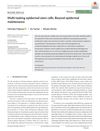Search
for
Did you mean Epidermal Stem Cells?
Learn
4 / 4 resultslearn Osteopontin
signaling protein that, when suppressed, may grow hair by reducing inflammation and stem cell loss
learn Low Level Laser Therapy
laser therapy for anti-inflammatory and likely insignificant hair regrowth effects
learn Epidermal Growth Factor
Research
5 / 1000+ results
research Epidermal Homeostasis: A Balancing Act of Stem Cells in the Skin
Skin stem cells are crucial for maintaining and repairing the skin and hair, using a complex mix of signals to do so.

research Multi-Tasking Epidermal Stem Cells: Beyond Epidermal Maintenance
Epidermal stem cells have various roles in skin beyond just maintenance, including forming specialized structures and aiding in skin repair and regeneration.
research Development and Maintenance of Epidermal Stem Cells in Skin Appendages
Epidermal stem cells create and maintain skin structures like hair and nails through specific signaling pathways and vary by location and function.

research ASH2L Mediates Epidermal Differentiation and Hair Follicle Morphogenesis via H3K4me3 Modification
ASH2L is essential for skin and hair development.
research WWOX Deficiency Causes Downregulation of Prosurvival ERK Signaling and Abnormal Homeostatic Responses in Mouse Skin
WWOX deficiency in mice causes skin and fat tissue problems due to disrupted cell survival signals.
Community Join
5 / 81 resultscommunity The Real Cause Of Androgenetic Alopecia
Androgenetic alopecia is caused by DHT affecting hair growth. Finasteride and minoxidil are used to manage hair loss by blocking DHT and promoting hair growth.
community Story time! The Great Unbalding (PP405)
PP405 is a promising new hair loss treatment that may reactivate dormant hair follicles without side effects. It could surpass traditional treatments like minoxidil and finasteride if successful in further trials.
community So we have 20k dollars human like machines available but no new effective treatment for hairloss since finasteride :)
There have been no new effective hair loss treatments since finasteride, despite technological advancements. Current treatments include finasteride, minoxidil, and RU58841, with ongoing challenges and potential future solutions in research.
community If you aren't happy with your results but haven't tried microneedling: why not?
Microneedling with minoxidil significantly boosts hair growth, even for non-responders to minoxidil alone. The routine includes a 1.5mm dermaroller weekly and minoxidil twice daily, with some users adding finasteride and tretinoin.
community Clearing the air on how non-surgical treatments really work
Treatments for hair loss, including finasteride, dutasteride, minoxidil, ketoconazole, microneedling, and low level laser light therapy, which aim to reduce DHT production, increase cell absorption and blood flow, and stimulate epidermal stem cells. It also stresses the importance of patience when using these treatments.